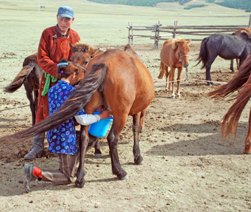
Getting there
Mongolia is a large country and to reach many geological sites needs a week or more of bone-breaking travel – few roads outside of Ulaan Baatar are more than dirt tracks. Fortunately by Mongolian standards the volcanoes of the Hangay Dome are accessible and can be reached by a mere two days’ hard driving from Ulaan Baatar. Yo Majigsuren, our colleague from Mongolian University of Science and Technology, recommended a Furgon for transport, an ancient but robust Russian van favoured by Mongolians because vehicles need to be fixed wherever a breakdown might occur.
If transportation is the bane of Mongolian fieldwork, the boon lies in its simplicity. Since well before the times of Genghis Khan, the economy of central Asia has centred on roaming herds of sheep, yak, camels or horses, and this has spawned a rich nomadic culture. As a result, there is almost nowhere across the steppes of central Asia where you can not pull off the road and put up a tent. Food is equally uncomplicated. Majigaa arranged for a sheep to be slaughtered on the first day out from Ulaan Baatar. According to tradition, she boiled the intestines almost immediately and offered them around as a breakfast delicacy while the rest of the animal was butchered and thrown into the back of the van. The meat lasted a week without refrigeration. As for drink, the horses provide it. The Mongolian steppe is littered with gers, round white tents, many of which sell fermented horse’s milk from the family herd. I doubt that the alcoholic yoghurt airag would catch on abroad, but it is nutritious and its effects break up the tedium of the long uncomfortable drives.